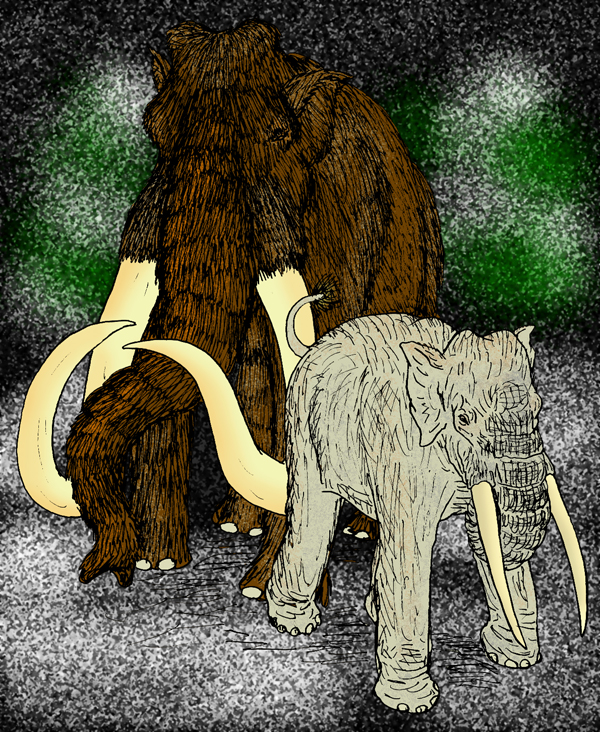Steppe Mammoth (Mammuthus trogontherii) - Wiki Steppe mammoth
From Wikipedia, the free encyclopedia
Order: Proboscidea
Family: Elephantidae
[Photo] Reconstructions of the prehistoric elephants Mammuthus trogontherii (The Steppe Mammoth), and Elephas namadicus (The Asian Straight-Tusked Elephant), of Pleistocene China. (C) Stanton F. Fink. URL: http://en.wikipedia.org/wiki/Image:Mammuthus_trogonotherii.JPG
Copyright (C) Stanton F. Fink
Permission is granted to copy, distribute and/or modify this document under the terms of the GNU Free Documentation License, Version 1.2 or any later version published by the Free Software Foundation; with no Invariant Sections, no Front-Cover Texts, and no Back-Cover Texts. A copy of the license is included in the section entitled "GNU Free Documentation License". |
The
steppe mammoth,
Mammuthus trogontherii, is an extinct species of
elephant, that ranged over most of northern Eurasia during the Late Pleistocene, 600,000-370,000 KYA.
The
steppe mammoth probably evolved in the early Pleistocene of siberia from
Mammuthus meridionalis, which was replaced during the middle pleistocene about 750.000 - 500.000 years ago. It was the first stage in hte evolution of the steppe and tundra
elephants and an ancestoer of the
woolly mammoth of the later glacial periods. Standing up to 4.70 m (15 ft) tall at the shoulder, it is among the largest probiscideans to have ever lived, along with
Mammuthus meridionalis and
Deinotherium. Its spiral-shaped tusks could be as long as 5.20 m (17 ft) in old bulls. About 250.000 years ago, the
woolly mammoth appeared in Europe, which derived in northern Asia from the
steppe mammoth and replaced its progenitor completely.
Its skull was shorter than that of the great southern
elephant. The males had spiral tusks with a recurved tip, while the females had thinner and only slightly curved tusks. The tusks grew to considerable lengths and the largest one knwon must have measured about 5 m. on a living animal.
The most complete skeleton of a
steppe mammoth yet found was discovered in 1996 in Kikinda, Serbia. It has recently been mounted and put on display. The specimen is a female, which was about 4.7 m (15½ ft) high, with 3.5 m (11½ ft) long tusks, and would have weighed an estimated 7 tonnes when alive. This suggests even greater dimensions for males from the same area. It therefore seems that M. trogontherii is not only the biggest species of the genus Mammuthus, but is possibly among the biggest species in the order
Proboscidea, rivaling in size not only
Elephas recki and the Straight-tusked
elephant Palaeoloxodon but, perhaps, even
Deinotherium itself.
http://en.wikipedia.org/wiki/Steppe_mammoth| The text in this page is based on the copyrighted Wikipedia article shown in above URL. It is used under the GNU Free Documentation License. You may redistribute it, verbatim or modified, providing that you comply with the terms of the GFDL. |
